Bulletin – September 2012 Chinese Urban Residential Construction
- Download the article 148KB
Abstract
Rapid urbanisation in China has been a key driver of global steel demand and therefore demand for iron ore and coking coal. This article considers the medium- and long-term prospects for residential construction in China and their implications for steel consumption. Residential construction is projected to remain at a high level for the next couple of decades. Steel consumption in this sector is expected to be boosted further by demand for higher quality buildings. Some alternative scenarios are considered, examining both upside and downside risks.
Introduction
In 2010, China constructed more residential floor space than the entire dwelling stock in Australia. This high level of construction follows two decades of strong growth, during which the amount of annual floor space completed more than doubled. All of this increase in residential construction has been driven by construction in urban areas, while construction in rural areas has stagnated (Graph 1).[1]

Residential construction is an important source of Chinese growth; directly, dwelling investment is estimated to have accounted for around 9 per cent of GDP in 2011, compared with 5½ per cent in 2004 (Graph 2). As a consequence, China's increased appetite for raw materials has resulted in a significant increase in Australian commodity exports, especially for iron ore and coking coal. This article looks at some factors that are integral to the residential construction boom in China – such as urban population, dwelling size and dwelling demolitions – and also considers the medium- and long-term outlook for the sector. Further details can be found in the related Research Discussion Paper, Berkelmans and Wang (2012).
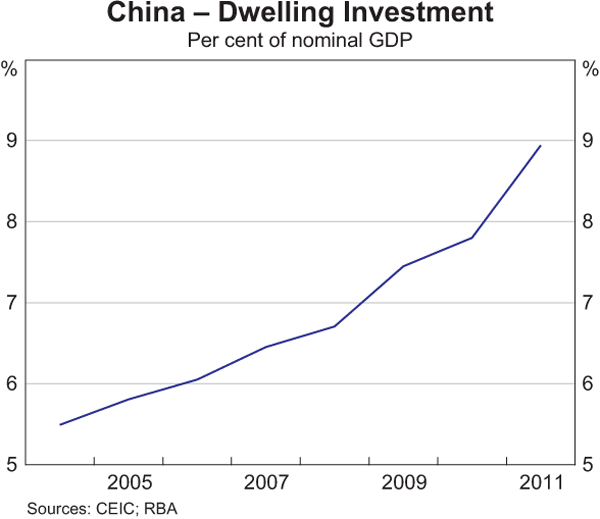
Factors Influencing Residential Construction Growth
Although total population growth has slowed since the introduction of the family planning policy in 1978, urban population growth has remained high (Graph 3). This trend has been underpinned by large flows of rural migrants to urban areas, accompanied by the large-scale transformation of rural land into urban land. This upward trend is projected to be sustained in the medium term, with China's urban population expected to increase by 42 per cent over the next two decades; by 2030, roughly 70 per cent of the country's population is projected to be living in urban areas.[2] By comparison, Australia's urbanisation rate is almost 90 per cent, while the urbanisation rate is more than 80 per cent in the United States.[3] Despite the continued increase in China's urban population, the growth rate is expected to slow over the next 20 years.
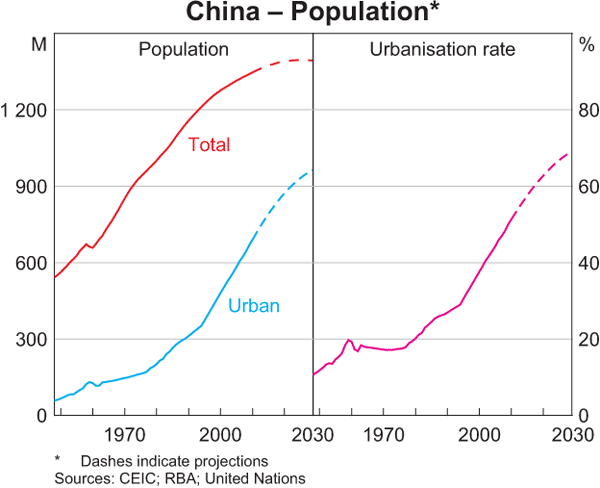
Strong urban housing demand in recent years has been influenced by the population's age structure (Graph 4). With a large number of people born between 1986 and 1990, the share of the population aged between 15 and 64, who are potentially looking to rent or purchase a home, is likely to be close to its peak (Rush 2011).
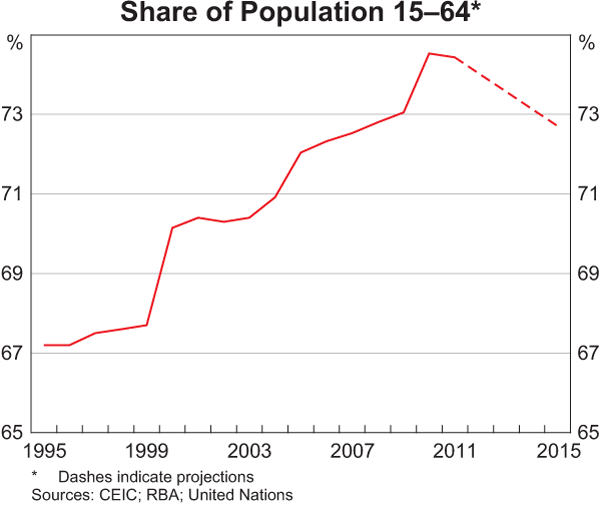
Increases in average living space have accompanied the rise in demand associated with the growing urban population. Chinese urban residential floor space per capita is estimated to be around 22½ square metres in 2010, more than double its level in 1990 (Graph 5).[4] As China develops further, and incomes rise, floor space per capita is projected to continue its upward path. If the relationship between incomes and dwelling size is consistent with international experience, and the Chinese economy grows along the path projected in World Bank and Development Research Center of the State Council, the People's Republic of China (2012), then floor space per capita should increase to around 35 square metres by 2030.[5] This compares with levels of approximately 60 square metres in Australia and the United States.[6]
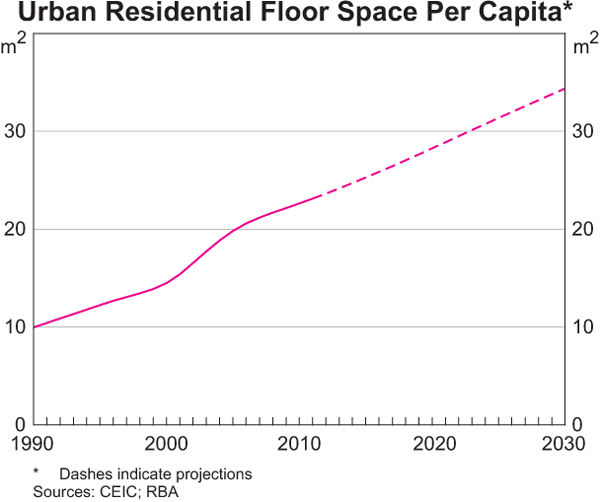
Just as higher incomes increase the demand for floor space, they also increase the demand for higher quality buildings. As a result, demolitions are running at a high level as low quality buildings are replaced with higher quality buildings. According to the State-owned Assets Supervision and Administration Commission of the State Council (SASAC), around 1.8 billion square metres of residential floor space were demolished between 2008 and 2010. This volume of demolition was equivalent to around 40 per cent of the total urban residential floor space constructed during this period (SASAC 2011). According to estimates of the urban dwelling stock, this corresponds to an annual demolition rate of around 4.5 per cent. This rate is expected to decline over the next two decades to levels more consistent with international norms of about 2 per cent.
The sequence of housing reforms introduced since the early 1980s has facilitated a strong response of supply to demand pressures. Until the late 1990s, many residential properties were provided at a heavily subsidised rate by the government or state-owned enterprises. Since residents had to repay these subsidies upon gaining the right to sell, and relinquish the capital gain, the residents had very little appetite to purchase property as an investment. The housing reforms enabled private property ownership and allowed certain properties to be traded at a market price (known as ‘commodity building’). This saw a large increase in private construction, albeit partially offset by a reduction in state-sponsored construction. Consequently, over the past two decades, commodity building has increased significantly as a share of urban residential property constructed (Graph 6). The number of people owning multiple properties has also increased (Huang 2011).
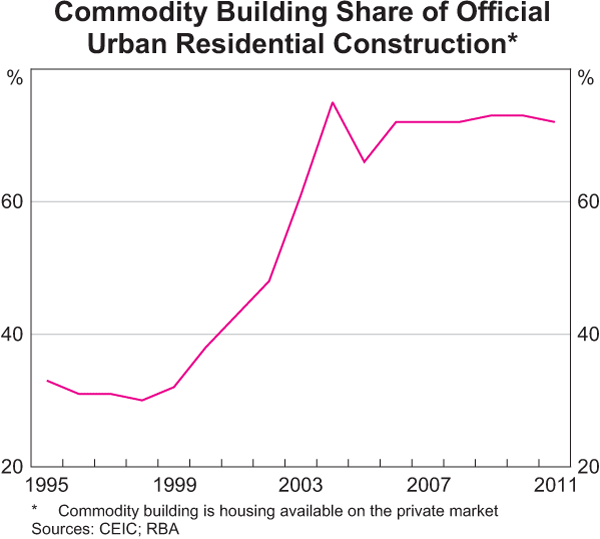
The Outlook for Residential Construction
The projected increase in the urban population, greater demand for larger apartments and the trends in demolition can be used to formulate a projection for total urban residential construction. This projection points toward an increase in residential construction in the coming years, though at a slower pace than in the recent past (Graph 7). The level of urban residential construction is expected to peak by the end of this decade, at a level that is about 12 per cent higher than in 2011. Thereafter, urban residential construction is expected to decline, but nevertheless remain at high levels. By 2030, it is expected that urban residential construction will be at a similar level to the current scale of construction.
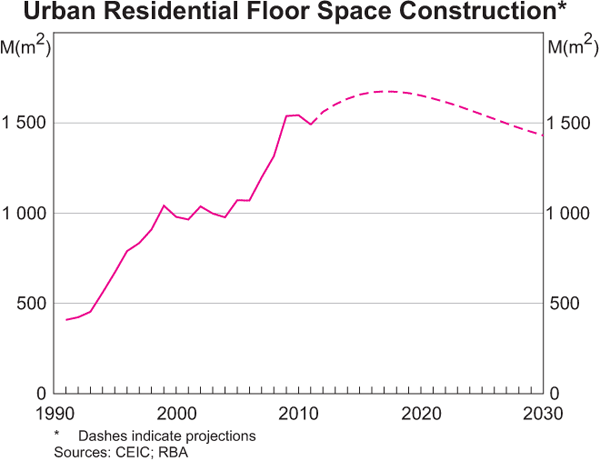
Of course, these central projections are subject to considerable uncertainty, and their sensitivity to the underlying assumptions can be considered. First, suppose that the per capita growth of the economy remains above 8 per cent per annum for the next two decades (compared with an average of 6 per cent in the central projection), along with an unchanged profile for the population and urbanisation. In this case, the peak in residential construction would occur much later, as wealthier urbanites would demand larger living space (Graph 8). Construction would peak in 2023, at a level approximately 25 per cent above 2011 levels. Alternatively, a lower path can be projected by assuming an urbanisation path more in line with the United Nations' urbanisation projections as they stood in 2009, which were significantly below the current vintage. In this case, the peak in residential construction is basically at hand. These alternatives, among others, are detailed further in Berkelmans and Wang (2012).

The Implications for Steel Demand
Steel intensity – the average amount of steel used per square metre of floor space – can vary depending on the type of building structure, the height of the building and other features. Taller buildings – required to accommodate higher population densities in cities across China – require more steel per square metre of floor space in order to maintain structural integrity. Also, a sizeable increase in automobile ownership in the coming years is likely to stimulate demand for buildings with underground car parking, which also requires more steel to be used per square metre of living space (Baker and Hyvonen 2011). For these reasons, even though growth in residential construction is likely to decline over the coming decades, the growth of steel demand is not likely to decline to the same extent. Indeed, average steel intensity has increased steadily over the past 30 years. Some estimates suggest that the average steel intensity for newly constructed apartments in China is currently around 60 kilograms of steel per square metre (Hu et al 2010; Walsh 2011).
The increase in average steel intensity means that the steel consumed by residential construction is projected to peak several years after aggregate construction is projected to peak (Graph 9). According to the central projection, the peak steel requirement is expected to occur around 2023. This represents an approximate 30 per cent increase over the current levels. Graph 9 also shows the implied pattern of steel use in construction under the two alternative assumptions discussed above.

While steel demand from urban residential construction is projected to moderate from 2023, the outlook for the steel sector depends on more than just the outlook for construction. Indeed, notwithstanding the growth of steel used in residential construction, the share of steel demand accounted for by residential construction in China has declined over the past decade (Graph 10). Among other things, this is attributable to a surge in the production of manufactured products. Nonetheless, the needs of the Chinese residential sector augur well for Chinese steel consumption.
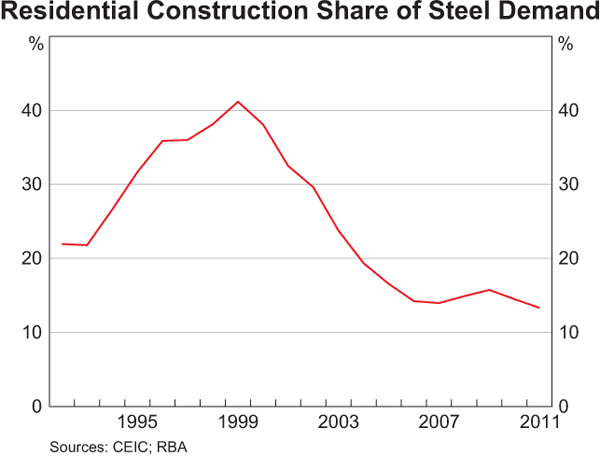
A large share of China's iron ore used for steelmaking is imported, and Australia is well placed to retain its position as the largest supplier of iron ore to China in the coming years, particularly given the relatively low cost of extraction of iron ore in Australia. China's imports of coking coal are also expected to remain elevated in the coming years, though less than 10 per cent of China's coking coal demand is met through imports, of which Australia is a large supplier.
Footnotes
The authors are from Economic Group. [*]
Urban residential floor space construction reported here is different from the official data published by the National Bureau of Statistics of China. The measure here includes rural residential buildings with a ‘steel structure’, which accounts for 70 per cent of total rural construction in 2010. These buildings, which would usually be multistorey, are treated as urban construction because most of these buildings are believed to be located in areas that will later be reclassified as urban. More details can be found in Berkelmans and Wang (2012). [1]
The total and urban population forecasts presented in this paper closely follow the methodology used by United Nations (2012). [2]
These urbanisation rates are based on definitions applied by each country's statistical agency, so there are limitations to comparability. [3]
This paper quotes a smaller average dwelling size than official estimates because the official estimates are based on non-agricultural household registration (hukou) population, which is smaller than the actual urban population (Beijing Municipal Bureau of Statistics 2006). [4]
The World Bank and the Development Research Center has economic growth gradually falling from an average of 8.6 per cent per year during 2011–2015 to 5.0 per cent per year in 2026–2030. [5]
These numbers are based on RBA calculations and data from the Australian Bureau of Statistics and International Energy Agency (IEA 2004, 2007). [6]
References
Baker M and M Hyvonen (2011), ‘The Emergence of the Chinese Automobile Sector’, RBA Bulletin, March, pp 23–29.
Beijing Municipal Bureau of Statistics (2006), ‘北京局队就2005年本市城镇居民人均住房面积有关情况做出说明’ (An Explanation of the 2005 Average Urban Residential Living Area in Beijing by the Beijing Municipal Bureau of Statistics), press release, 9 July. Available at <http://www.bjstats.gov.cn/tjys/sjzd/200607/t20060710_45447.htm>.
Berkelmans L and H Wang (2012), ‘Chinese Urban Residential Construction to 2040’, RBA Research Discussion Paper No 2012-04.
Hu M, H Bergsdal, E van der Voet, G Huppes and DB Müller (2010), ‘Dynamics of Urban and Rural Housing Stocks in China’, Building Research & Information, 38(3), pp 301–317.
Huang Y (2011), ‘Second Home Ownership in Transitional Urban China’, Housing Studies, 26(3), pp 423–447.
IEA (International Energy Agency) (2004), Oil Crises and Climate Challenges: 30 Years of Energy Use in IEA Countries, OECD Publishing, Paris.
IEA (2007), Energy Use in the New Millennium: Trends in IEA Countries, OECD Publishing, Paris.
Rush A (2011), ‘China's Labour Market’, RBA Bulletin, September, pp 29–38.
SASAC (State-owned Assets Supervision and Administration Commission of the State Council) (2011), ‘中国资源综合利用协会申请设立建筑垃圾资源化再利用工作委员会’ (China Association of Resource Comprehensive Utilization Propose to Set-up a Working Committee on the Recycling of Construction Waste), press release, 23 March. Available at <http://www.sasac.gov.cn/n1180/n1566/n259760/n1902523/n1904676/13344619.html>.
United Nations (2012), ‘World Urbanization Prospects: The 2011 Revision’ database, Department of Economic and Social Affairs, Population Division. Available at <http://esa.un.org/unpd/wup/index.htm>.
Walsh S (2011), ‘New Opportunities for Industry Growth’, Presentation to Metal Bulletin Conference ‘China Iron Ore 2011’, Beijing, 23–24 March. Available at <http://www.riotinto.com/documents/110324_New_opportunities_for_industry_growth_Sam_Walsh.pdf>.
World Bank and Development Research Center of the State Council, the People's
Republic of China (2012), China 2030: Building a Modern, Harmonious, and Creative High-income Society,
World Bank, Washington DC. Available at <http://www-wds.worldbank.org/external/default/WDSContentServer/WDSP/IB/2012/02/28/
000356161_20120228001303 Rendered/PDF/671790WP0P127500China020300complete.pdf>.